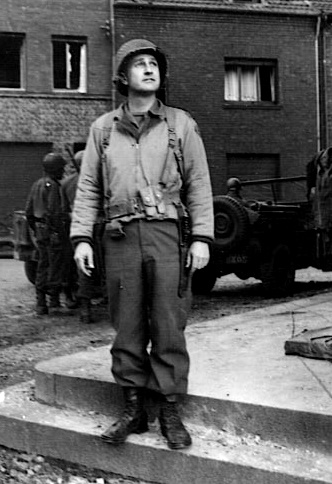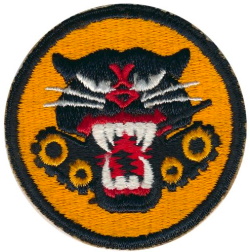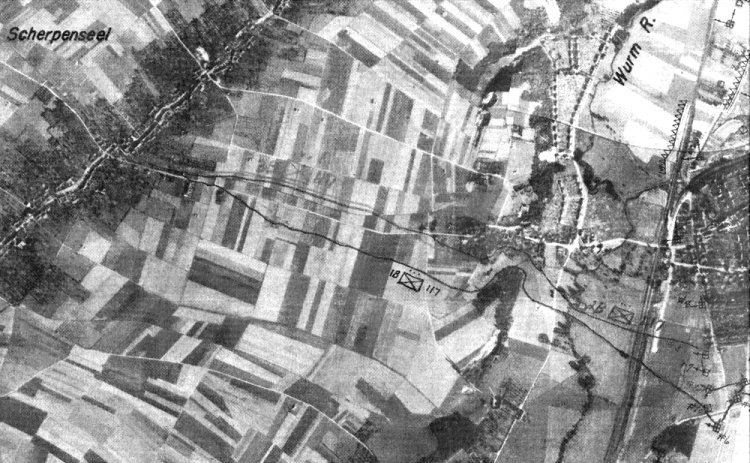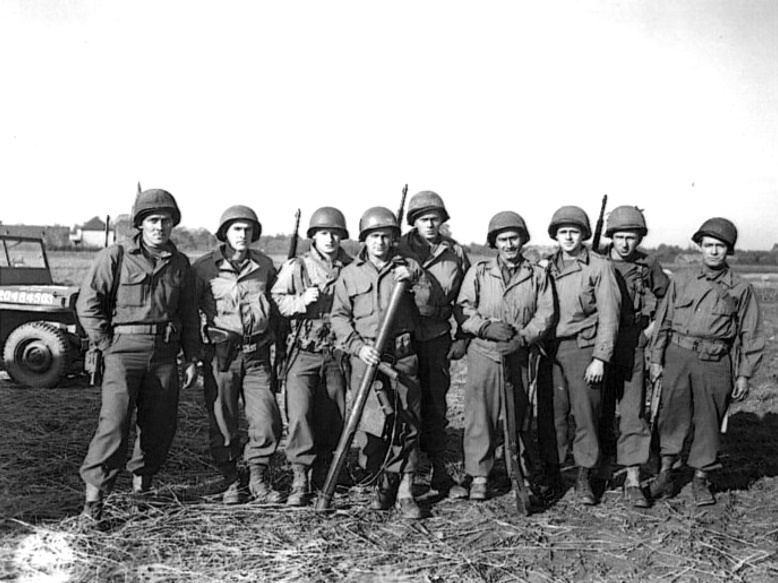Document Source: Appendix C, Narrative Account of the 117th Infantry Regiment, Interview with Col Robert E. Frankland, CO 1/117th Infantry; Maj Henry R. Kaczowka, Battalion Executive; Capt. David K. Easlick, Battalion S-3; Lt Stanley W. Cooper, Dog Co, Heavy Weapons; Lt William J. O’Neil, Leader Pioneer Platoon. October 12, 1944. Interview conducted by Capt Hechler, Assistant Corps Historian.

 The mission of the 1st Battalion of the 117th Infantry Regiment (30-ID) on October 2, 1944, was to cross the Wurm River and neutralize the pillboxes in the area boarded roughly by the Palenberg – Rimburg railroad track on the west over to the western edge of Ubach. The 1st Battalion was the assault battalion of the regiment, which advanced in battalion line formation.
The mission of the 1st Battalion of the 117th Infantry Regiment (30-ID) on October 2, 1944, was to cross the Wurm River and neutralize the pillboxes in the area boarded roughly by the Palenberg – Rimburg railroad track on the west over to the western edge of Ubach. The 1st Battalion was the assault battalion of the regiment, which advanced in battalion line formation.
Col Frankland is a firm believer in thorough and scientific training for an operation of this character. He trained his battalion in a similar fashion prior to their crossing of the Vire River. Before assaulting the Siegfried Line, the battalion drilled for two weeks in all phases of the coming operation. Although committed in the line all but two days of this period, they were in a static holding position and had the opportunity to review and analyze while waiting for favorable weather conditions for the air strike. During this period, the battalion occupied defensive positions north of Scherpenseel. Lt Morgan (S-2) with the assistance of S/Sgt Flow (Operations Sergeant) constructed a sand table by boarding up the sides of a 12′ x 5′ table in an old German headquarters building which was the battalion CP. Cabbage leaves were used for vegetation, inked wooden blocks for houses, and numerous other expedients showed the space relationships and strength of pillboxes, wire, the Wurm River, the ridge west of the river, the railroad, and other terrain features. Pillboxes were numbered in red, company and platoon responsibilities were clearly drawn on the sand table, and Col Frankland feels that one of the primary reasons the operation proceeded so smoothly was that everybody understood and visually saw his mission on the sand table.
Early in the morning of September 25, the battalion withdrew to positions about 3000 M west and went into a training area. Elements of the 2d battalion of the 117th Infantry Regiment had relieved the 1st in the line during the night, and the 1st departed for two full days of intensive work with pole and satchel charges, flame throwers, Bangalore torpedoes, dry runs for assaulting pillboxes and river crossing practice. While some of the men were engaged in these activities, the rest were practicing firing 60-MM and 81-MM mortars, 57-MM AT/AP guns, bazookas, rifle grenades, and machine guns.
 When the battalion went out to the area, only one man knew how to operate a flame thrower. All the training we had in the States and in England was now useless explained Col Frankland because all of our assault detachments had been wiped out in previous battles and there was a complete turnover in battalion personnel. We had to start from scratch. I had learned a lesson. This time instead of training only assault detachments, we set out to familiarize all personnel with all tools. That proved fortunate on the day of the assault, for whenever the leading elements were cut down, the nearest man could always pick up the weapon and do the job. Able Co, 105th Engineer Combat Battalion sent an entire platoon of specialists to the training area, with plenty of practice equipment for everybody. The first half-day was spent in all-around familiarization, and then the battalion proceeded to more specialized training for primary tasks. Training for the river crossing was done in a gully with stagnant water about the width of the Wurm River, 12-15 feet. Col Frankland states that as the assault actually took place on October 2, the river crossing turned out to be almost as important as the taking of the pillboxes, because the enemy was surprised and overwhelmed by the sheer aggressiveness of the speedy crossing of the river.
When the battalion went out to the area, only one man knew how to operate a flame thrower. All the training we had in the States and in England was now useless explained Col Frankland because all of our assault detachments had been wiped out in previous battles and there was a complete turnover in battalion personnel. We had to start from scratch. I had learned a lesson. This time instead of training only assault detachments, we set out to familiarize all personnel with all tools. That proved fortunate on the day of the assault, for whenever the leading elements were cut down, the nearest man could always pick up the weapon and do the job. Able Co, 105th Engineer Combat Battalion sent an entire platoon of specialists to the training area, with plenty of practice equipment for everybody. The first half-day was spent in all-around familiarization, and then the battalion proceeded to more specialized training for primary tasks. Training for the river crossing was done in a gully with stagnant water about the width of the Wurm River, 12-15 feet. Col Frankland states that as the assault actually took place on October 2, the river crossing turned out to be almost as important as the taking of the pillboxes, because the enemy was surprised and overwhelmed by the sheer aggressiveness of the speedy crossing of the river.
Practice crossings were made with ladders or duckboards consisting of varying lengths from 15-20 feet. These devices were four feet in width and provided a firm footing because the ladder rungs were very close together. During training, two were thrown into the water to make a V-shaped base, and the third was flung across the base to make a level foot-crossing possible. During the actual operation, Lt O’Neil states that in some cases it was possible to cross with only one of the boards, and in other cases, only two were actually needed.

 The initial plan for the river operation was to cross in assault boats. However, Lt O’Neil sold Col Frankland on the idea of using the ladders, which had previously been employed in the crossing of the Vire et Taute Canal. The actual construction of these devices was accomplished by the 105-ECB. After dark, on September 26, the battalion returned to its positions around Scherpenseel and went back into the line. Training proceeded with the sand table until D-day. Not only the riflemen but Heavy weapons men, the tank destroyer, and the tank commanders and engineers all studied what was to be their roles. As D-Day approached, some changes were made in the sand table as a result of information brought in by patrols.
The initial plan for the river operation was to cross in assault boats. However, Lt O’Neil sold Col Frankland on the idea of using the ladders, which had previously been employed in the crossing of the Vire et Taute Canal. The actual construction of these devices was accomplished by the 105-ECB. After dark, on September 26, the battalion returned to its positions around Scherpenseel and went back into the line. Training proceeded with the sand table until D-day. Not only the riflemen but Heavy weapons men, the tank destroyer, and the tank commanders and engineers all studied what was to be their roles. As D-Day approached, some changes were made in the sand table as a result of information brought in by patrols.
Col Frankland paid tribute to the intrepid spirit of the men who probed the enemy lines and brought back answers to such questions as how rough was the terrain, how steep the banks of the river were, and how formidable an obstacle was the barbed wire. I can still remember the first patrol conducted by Lt Cushman, a platoon leader in Baker Co. He came back dripping wet from the shoulders down, having waded across the Wurm River. He found, by reconnoitering the river on both sides, the best places to cross eventually used on October 2, by Baker Co. First reports revealed an almost impassable hedge along the side of the railroad, but a gap was discovered on one of these preliminary patrols. Likewise, a spot was found where the barbed wire ended, allowing for passage.
Col Frankland and his S-3, Capt Easlick, both made several air reconnaissance over the area in Piper Cubs. The main result of these air trips was the conclusion that Baker Co did not have sufficient width of the area to maneuver across the open space down to Wurm River, and the Baker Co area was subsequently widened. The plan of attack for October 2 called for Baker and Charlies Cos to move up in the assault wave, abreast, with two platoons forward and one back in each case. Able Co, the support company, was to be prepared to move forward and come into the line to replace whichever company seemed to be bogging down. From a planning standpoint, explained Col Frankland, Able Co had the toughest job. Its commanders and men could not concentrate on certain specific pillboxes, terrain, and points along the Wurm River because they could not be sure whether they would be operating in the Baker or the Charlie Cos sector; so they had to be prepared for everything. Night after night while we were waiting in Scherpenseel, Capt John Kent, Able Co CO, wou]d pull his support platoon out of the line and come back to the battalion CP to pore over tiE sand table until close to midnight.
There was a new tactical angle to the role assigned to Able Co in the breaching of the Siegfried Line. In crossing the Vire River, Col Frankland had discovered that the support company suffered many losses from artillery dropping in the rear of the assault companies. Therefore, he decided to hold Able Co in Scherpenseel and wait until Baker and Charlie Cos had pushed to the river, if possible, before committing it. The plan worked perfectly, and much enemy artillery dropped behind Baker and Charlie Companies where it might have caused many Able Company casualties if Able had followed close behind. Dog Co (Heavy Weapons) was disposed of with half of the heavy machine guns on the left flank supporting Baker Co, and the other half on the right flank supporting Charlie. The 81-MM mortars remained in 5cherpenseel and were fired from locations near the town.
The battalion was below T/O strength at the time of the jump-off on October 2. Able Co was in the weakest condition, and the entire battalion was short 100 men. Despite the shortage, Col Frankland described combat efficiency as excellent in view of the training for the operation. The battalion was well-supplied before and during the operation. It was discovered prior to D-Day that the pole and satchel charge had gotten wet during training, and some of them would not go off; they were all replaced prior to the jump-off.
For several days prior to October 2, the 155-MM self-propelled guns of the 258th Field Artillery Battalion had been firing at the pillboxes, and Col Frankland praised their effectiveness. Even though personnel could remain in the pillbox, he stated that many of the shots penetrated and widened the embrasures so as to make shots easier for infantry riflemen and machine gunners. The artillery of the 118th Field Artillery Battalion was effective in delivering a ‘close barrage’ just ahead of the advancing assault waves. The 81-MM mortars fired 1525 rounds on D-Day from Scherpenseel. They were not effective against the pillboxes but were very effective in keeping the enemy outside of the pillboxes from emerging too aggressively from their foxholes. Col FrankJand believes that the most effective of any supporting fire came from the 4.2 chemical mortar barrage; it was this more than any of the other supporting fires which, laid 150 yards ahead of the assault companies, and also fired accurately into the defiladed terrain positions, kept down enemy fire until Baker and Charlie Cos stormed across the river. The air strike did not hit any of the pillboxes in the 117-IR sector. Palenberg was bombed quite effectively, but the net advantage of the strike was very little.
ATTACK
The companies jumped off at 1100 and moved speedily across the open space. I had learned in the Normandy hedgerow country that if you sat still you got mortars and artillery, and so there and here, I say to my men to keep moving fast and they will have fewer casualties, said Col Frankland. Several of the 1st battalion officers seconded this thought and noted that for an entire week prior to D-Day, the battalion commander had repeatedly emphasized that on D-Day everybody would have to move fast. This thought keynoted many talks of the battalion commander, and it went down the chain of command from the platoon leaders to the men. I told them we’d have to get down to the river between a fast walk and a dog trot, Col Frankland said, and that’s just what they did in battle.
Baker and Charlie Cos met no opposition to the crest of the hill overlooking the Wurm River, and the heavy machine guns sneaked down with the riflemen to take positions on the flanks at the hillcrest where they could fire observed fire at the pillboxes. As part of the regimental fire plan, the 81-MM mortars continued to fire along the river line near the left of the battalion sector, and then shifted to the pillbox area across the railroad tracks where the assault waves descended toward the river. Both companies met heavy opposition in the descent to the river. Artillery and mortar fire increased. Charlie Co on the right was hit harder than Baker; Col Frankland feels that the reason for this was that Baker a more covered route of approach, was harassed by fire from both the front and right flanks and that more mortar and artillery from the enemy just happened to be dropping in that sector. In any event, the heavy losses suffered by Charlie Co caused its drive to lag when it reached the river.
In contrast, Baker Co crossed the river briskly. The Wurm is only 3-4 feet deep and 15-20 feet wide, but is potentially a good defense line because it may slow up an advance long enough to enable small arms and artillery to be devastating. One of the key figures in the Baker Co crossing was towering 1/Lt Don Borton, who spark-plugged and enthused the men by dashing into the stream with the first duckboard and throwing it down on the far bank to start the foot crossing. The men double-timed across. Others who couldn’t wait for the duckboard waded across. Surprised by the speed and timing of the crossing, 11 of the enemy surrendered in the Baker Co area when confronted by swarms of charging Americans.
It was noon, and only an hour after the jump-off, but Charlie Co had 87 casualties in that hour: 7 killed, 68 wounded, and 12 combat exhaustion. Some men of Charlie Co continued on across the railroad track and had started to assault the first of the pillboxes when Col Frankland decided that the opportune time had arrived to send in his fresh company. From his CP at the crest of the hill, he radioed Able Co’s CO and ordered him to move up from Scherpenseel to take over Charlie Co’s mission. Able Co moved very quickly over the same route that Baker Co had taken; the strategy of keeping Able Co far enough in the rear had paid off, for now, there was clear sailing to the river. At 1225, the regimental commander received word that Able Co was on the line continuing the assault.
By this time, the heavy machine guns on the flanks at the crest of the hill were causing casualties in the pillboxes. By aiming for the embrasures the heavy MGs were able to keep the enemy down and also hit some between the eyes, as did the riflemen. But to determine the effectiveness of their fire, the heavy machine guns had to use tracer bullets; this quickly revealed their position and made them extremely vulnerable to enemy mortar fire. Of the eight machine guns operating, five were knocked out by mortars and there were about 20 personnel casualties in the Heavy Weapons Company.
Between the river and the railroad track, not much opposition was encountered. 25-30 enemies were dug in and well-concealed along the track, but they surrendered when the assault waves rushed in at top speed. Able and Baker Cos then prepared their assault detachments for the drive on the pillboxes. Each platoon had a 16-man assault detachment which had thoroughly studied the aerial photographs and all available information indicating where the apertures and the blind sides of the pillboxes were. The assault detachments were organized like the field manual with bazooka and BAR men, wire cutters, flame-throwers, Bangalore, pole and satchel charge carriers. They didn’t have to work over the wire with the Bangalore torpedoes or the wire cutters because the wire had already been pretty well torn up by the effective 4.2 chemical mortar barrage.






















